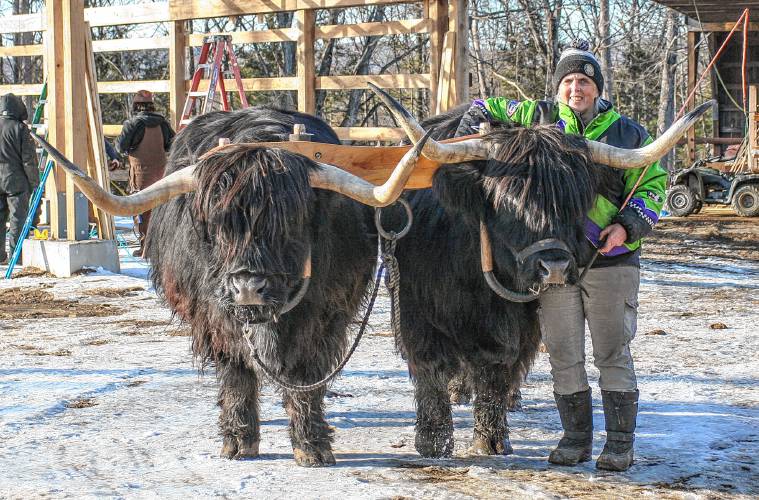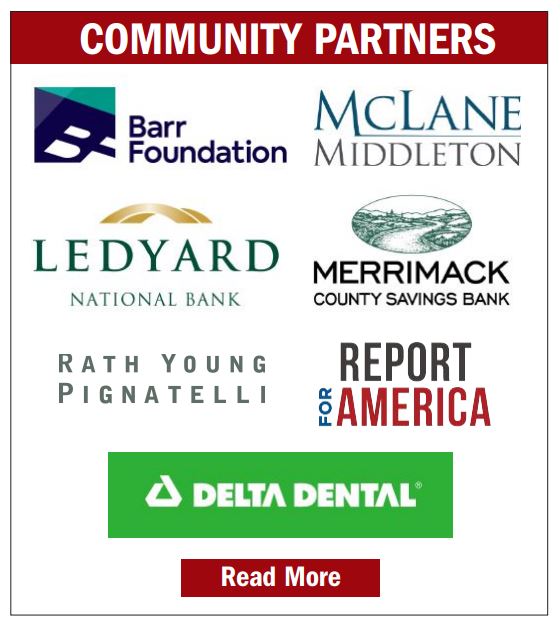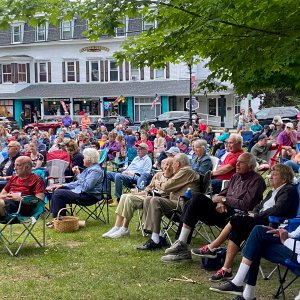From the farm: The magic of oxen

In 2021, Scottish Highland pair Topper and Stash worked as a team to pull logs out of the woods at Miles Smith Farm. Stash unexpectantly died two years ago, and Topper now has another partner named Finn. Carole Soule / For the Monitor
| Published: 03-09-2024 10:00 AM |
Each of the 27 bovines on Miles Smith Farm has a job. Cows give birth; bulls are dads; and steers (castrated bulls) are meat (usually). I had been a vegetarian until I realized that what I hated was the cruelty of feed lots and the abuse of cattle.
My cattle live good lives, and then I decide which ones go into the beef program. I don’t regret my decisions, but that doesn’t mean I’m not sad. Sometimes I cry. I remind myself I’m giving my cattle the best lives possible. If I’m going to eat meat, I’m going to feel the pain of my decisions.
But sometimes, there’s another job possibility for my steers: learning to be oxen. In the 1800s, teams of oxen were tractors of the day. Oxen still pulls loads, but it’s more of an intriguing sport than an agricultural necessity.
In 2012, after reading books and watching ox-drivers compete at the Deerfield and Hopkinton fairs, mainly 4H kids, I chose a matched pair of black, 6-month-old Scottish Highlanders for the yoke.
After much training, the steers, Topper and Flash, obeyed my voice commands. With just a stick in my hand and no lead rope, they did everything asked of them. After a training session, 800-pound Topper would rest his shaggy head on my shoulder and let me rub his neck like a dog. Magical. I never got hit by his majestic horns.
On the other hand, in 2015, when he was 3, Flash started shaking his head, rotating his long, pointed horns like the blades of a blender. He was dangerous and went into the beef program. Without a partner, Topper was out of a job. Other, more experienced teamsters told me to give up. Topper would never tolerate a young replacement for Flash; a steer his age couldn’t be trained — their advice: Retire Topper into the meat program and start with a new, younger pair. And pick a different breed; Highland cattle are unreliable, they said. Flash’s behavior supported that claim, but I’m stubborn as a mule.
I found another Highland steer the same age, size, and color as Topper, a perfect match. I named him Stash (short for Mooo-Stash) because Stash rhymes with Flash, and I began training him.
It went well until he met the stoneboat — a sturdy wood and metal sled that carries heavy things, like stones. When I showed him the stoneboat, Stash leaped into the air. Imagine an 800-pound, shaggy steer with massive horns with all four feet off the ground. Who said bovines can’t jump?
Article continues after...
Yesterday's Most Read Articles
Then I showed him the stoneboat chain. Same thing. Airborne again. Stash had to overcome his fear, or Stash and Topper would be in the beef program.
With untrained Stash nearby, I led Topper back and forth over the stoneboat. After watching Topper, Stash stepped over the stoneboat. Then I rattled the chain on Topper’s back. Stash, let me do the same. Training proceeded.
For years, Topper and Stash have been competing in county fairs where they follow my voice commands, pulling a weighted sled around an obstacle course in the show ring. The 4H kids always do better, but we do OK, have fun, and nobody got hurt.
One time in the show ring, I walked one way, and the boys went another, off toward the announcer’s table. Oh, no! If they blundered into the announcer and her table, it would prove that Highlanders are unreliable, and it wouldn’t help my reputation either.
I yelled, “Topper, haw!” (Haw = left.)
Topper stopped, turned his head, and looked toward me as if to say, “Oh, there you are!” Pulling Stash away from disaster, he came right to me.
Topper is 12 years old now, weighs almost 2,000 pounds, and it’s still magical when he lays his shaggy head on my shoulder. A younger pair of steers in training – Pop and Corn – are promising beginners, and working with them is my special joy.
Carole Soule is co-owner of Miles Smith Farm (www.milessmithfarm.com), where she raises and sells beef, pork, eggs, and other local products. She can be reached at carole@soulecoaching.com. Carole also coaches humans, helping them achieve the impossible a little at a time.







 Lavender haze: Purple fields bloom at Warner farm
Lavender haze: Purple fields bloom at Warner farm Arts in the Park returns for July
Arts in the Park returns for July Hopkinton art gallery showcases “Creativity Beyond Convention”
Hopkinton art gallery showcases “Creativity Beyond Convention” AROUND CONCORD: Your guide to free summer music
AROUND CONCORD: Your guide to free summer music
